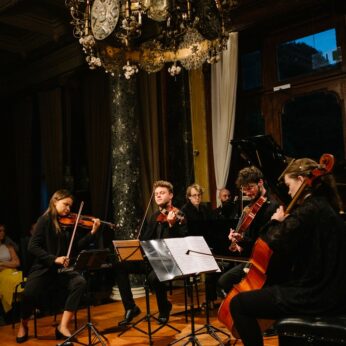Composer: César Franck (b. 1822 - d. 1890)
Performance date: 02/07/2022
Venue: Bantry House
Composition Year: 1879
Duration: 00:33:36
Recording Engineer: Eduardo Prado, Ergodos
Instrumentation: 2vn, va, vc, pf
Instrumentation Category:Piano Quartet/Piano Quintet
Artists:
Joseph Havlat -
[Piano]
Sonoro Quartet Mona Verhas, Jeroen de Beer [violins], Seamus Hickey [viola], Paul Heyman [cello] -
[quartet]

César Franck [1822-1890]
Quintet in F minor for piano and strings [1878-9]
1. Molto moderato quasi lento – Allegro
2. Lento con molto sentimento
3. Allegro non troppo ma con fuoco
Franck’s Piano Quintet was a succès de scandale – a seductive Irish student, an inflamed composer, an outraged and rejected pianist, the composer’s furious wife and a delighted audience made up the opening night’s imbroglio. The composer was known to have said that the young and beautiful private organ and composition student, Augusta Holmès, aroused in him the most unspiritual desires; the composer’s wife knew exactly what was going on whereas the pianist, Camille Saint-Saëns, sight-reading the piano part, only discovered this during the performance. Saint-Saëns, along with almost the entire male faculty of the Paris Conservatoire, was also passionately in love with Augusta, who had several times rejected his offers of marriage. This beautiful pythoness, Saint-Saëns wrote, was not satisfied with cultivating art and preaching art; she caused it to flourish all about her. As Venus fecundated the world when she knotted her tresses, so Augusta Holmès shook over us her reddish locks, and when she was prodigal with the lightning of her eyes and the brilliance of her voice, we ran to our pens, our brushes and works were born.
There cannot be much doubt about the passion of the opening; the strings unleash their theme before being silenced as the piano tries to reduce the temperature. This idea of two opposing visions that is announced in this lengthy introduction – one passionate, the other tender – goes on to be the dramatic thread running through the whole work. The Allegro main theme is finally revealed, a theme that dominates the movement in several rhythmic and harmonic transformations, briefly calmed by the so-called motto theme, a tender, yearning phrase that reappears in all three movements. The combination of these ideas is gradually built to a series of overwhelming climaxes and, finally, exhausted closure.
Vincent D’Indy has described the slow movement as raising itself aloft like a peak towards which the character-theme of the movement has directed its toilsome march, and from which it then descends to breathe out its life at the end in a sigh of grief. The decadent mood of this music has something of the flavour of Duparc’s settings of Baudelaire. It manages to rouse itself once when the peak is attained before collapsing again into inwardness and unattainable desire.
The Finale – Allegro non troppo ma con fuoco – opens with pulsating strings, which are soon brushed aside as the piano’s big, rhythmic and very masculine theme asserts itself. Thoughts of tenderness are crushed by this pounding theme until the motto theme reappears in the coda to remind us of what we are missing.
– Francis Humphrys
Copyright © 2024 West Cork Music. All rights reserved.
Designed and developed by Matrix Internet